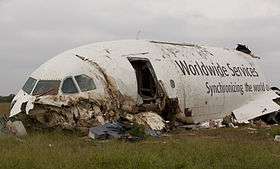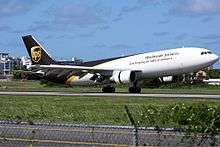UPS Airlines Flight 1354
 N155UP's forward section shortly after the crash and fire | |
| Accident | |
|---|---|
| Date | August 14, 2013 |
| Summary | Controlled flight into terrain due to pilot error |
| Site |
North of Birmingham's runway 18 33°35′2.061″N 86°44′51.9822″W / 33.58390583°N 86.747772833°WCoordinates: 33°35′2.061″N 86°44′51.9822″W / 33.58390583°N 86.747772833°W |
| Aircraft | |
| Aircraft type | Airbus A300F4-622R |
| Operator | UPS Airlines |
| IATA flight No. | 5X1354 |
| ICAO flight No. | UPS1354 |
| Call sign | UPS 1354 |
| Registration | N155UP |
| Flight origin | Louisville International Airport |
| Destination | Birmingham–Shuttlesworth International Airport |
| Passengers | 0 |
| Crew | 2 |
| Fatalities | 2 (all) |
| Survivors | 0 |
UPS Airlines Flight 1354 was a scheduled cargo flight from Louisville International Airport to Birmingham–Shuttlesworth International Airport. On August 14, 2013, the aircraft flying this route, a UPS Airlines Airbus A300-600F, crashed and burst into flames short of the runway on approach to Birmingham–Shuttlesworth International Airport in the US state of Alabama.[1][2] Both pilots were pronounced dead at the scene of the crash. They were the only people aboard the aircraft.[3]
Aircraft

The aircraft involved in the accident was an Airbus A300F4-622R, registered as N155UP. It was built in 2003; UPS took delivery of it in February 2004.[4] It was powered by Pratt & Whitney PW4000 engines. At the time of the accident, it had accumulated approximately 11,000 flight hours in 6,800 flight cycles (a flight cycle is one takeoff and landing).[5]
Crew
The captain of flight 1354 was 58-year old Cerea Beal, Jr.[6] Prior to being hired by UPS, Beal was employed by TWA as a flight engineer and then first officer on the Boeing 727. He was hired by UPS in October 1990 as a 727 flight engineer and became a 727 first officer in August 1994.[7] Twice, in 2000 and again in 2002, Beal began and then withdrew from training to upgrade to captain on the 727.[8] He transitioned to the A300 as a first officer in 2004 and then as a captain in 2009. At the time of the accident, he had accumulated 6,406 flight hours at UPS, 3,265 of which were on the A300.[7]
The first officer was 37-year-old Shanda Fanning.[9] Fanning was hired by UPS in 2006 as a 727 flight engineer. She became a first officer on the Boeing 757 in 2007, then transitioned to the Boeing 747 in 2009. She began flying the A300 in June 2012. At the time of the accident, she had accumulated 4,721 total flight hours, including 403 on the A300.[7]
Crash

At about 04:47 local time (CDT, 09:47 UTC) while making a localizer non-precision approach to runway 18 at Birmingham–Shuttlesworth International Airport, the aircraft suddenly clipped trees and struck ground three times uphill. The fuselage broke apart, with the nose coming to rest about 200 yards (180 m; 600 ft) away from the initial point of impact, and the rest of it about 80 yards (70 m; 240 ft) farther down towards the runway and about 1 kilometer (0.6 mi) from its edge and catching fire. Both pilots were killed.[10][2]
Investigation
.jpg)
The National Transportation Safety Board (NTSB) launched an investigation and sent a 26-member "go team" to the crash site to "collect perishable evidence". At a press conference held later on the same day, the NTSB said they had been unable to recover the cockpit voice recorder and the flight data recorder as the tail section (where the recorders are housed) was still on fire.[10] Both recorders were recovered on the following day, and were sent for analysis.[11]
At their third media briefing on August 16, 2013, the NTSB reported that 16 seconds before the end of the recording, the aircraft's ground proximity warning system sounded two "sink rate" alerts, meaning that the aircraft was descending too rapidly. Three seconds later, Captain Beal reported having the runway in sight, which was confirmed by First Officer Fanning. The CVR recorded the sound of the first impact with trees 3 seconds after the pilots reported seeing the runway. A final "too low terrain" alert by the GPWS was then recorded, followed by the final sounds of impact.[7] The crew had briefed the approach to runway 18 and were cleared to land by air traffic control two minutes prior to the end of the recording.[12][2]
.jpg)
To represent the country of manufacture, the French aviation accident investigation agency BEA, assisted by Airbus technical advisors, participated in the investigation.[13] Members of the FBI Evidence Response Team also assisted the NTSB.[14] The NTSB stated in late August that no mechanical anomalies had yet been uncovered, but that the complete investigation would take several months.[15]
On February 20, 2014, the NTSB held a public hearing in connection with its investigation. Excerpts from the cockpit voice recorder were presented, in which both the captain and first officer discussed their lack of sufficient sleep prior to the flight.[16]
.jpg)
On September 9, 2014 the National Transportation Safety Board announced that the probable cause of the accident was that the aircrew had made an unstabilized approach into Birmingham-Shuttlesworth International Airport during which they failed to adequately monitor their altitude. The aircraft descended below the minimum descent altitude when the runway was not yet in sight, resulting in controlled flight into terrain approximately 3,300 feet short of the runway threshold. The NTSB also found that contributing factors in the accident were:
- the flight crew’s failure to properly configure and verify the flight management computer for the profile approach;
- the captain’s failure to communicate his intentions to the first officer once it became apparent the vertical profile was not captured;
- incomplete weather information that led the flight crew to expect they would break out of cloud at 1,000 feet above ground level;
- the first officer’s failure to make the required minimums callouts;
- the captain’s performance deficiencies, likely due to factors including, but not limited to, fatigue, distraction, or confusion, consistent with performance deficiencies exhibited during training, and;
- the first officer’s fatigue due to acute sleep loss resulting from her ineffective off-duty time management.[17][1][18]
Aftermath
In 2014, the Independent Pilots Association filed suit against the FAA to end the cargo airplane exemption from the flight crew minimum rest requirements.[19] In 2016 the lawsuit was dismissed by a Washington, DC court, which determined the FAA had acted reasonably by excluding cargo airlines from the rest requirement based on a cost vs benefits analysis.[20]
Bret Fanning, husband of first officer Shanda Fanning, filed a lawsuit against Honeywell Aerospace in 2014, alleging that its ground proximity warning system installed on the A300 failed to alert the pilots that their aircraft was dangerously close to the ground.[21] Fanning claimed that the GPWS did not sound an alarm until one second after the aircraft began to clip the tops of trees;[21] however, the NTSB determined from the aircraft's flight data recorder that the GPWS sounded a "sink rate" warning when the aircraft was 250 feet above the ground, 8 seconds before the first impact with trees.[7]
See also
References
- 1 2 "ASN Aircraft accident Airbus A300F4-622R N155UP Birmingham Airport, AL (BHM)". Aviation Safety Network. Retrieved August 14, 2013.
- 1 2 3 Hradecky, Simon (August 16, 2013). "Crash: UPS A306 at Birmingham on Aug 14th 2013, touched down outside airport". The Aviation Herald. Retrieved August 17, 2013.
- ↑ Reeves, Jay (August 14, 2013). "UPS cargo plane crashes in Ala., killing two". The Boston Globe. Retrieved February 17, 2016.
- ↑ Rabinowitz, Jason (August 14, 2013). "UPS Airbus A300 Crashes On Approach To Birmingham Airport". NYCAviation. Retrieved August 14, 2013.
- ↑ "N155UP United Parcel Service (UPS) Airbus A300F4-622R - cn 841". Planespotters.net. Archived from the original on August 20, 2013. Retrieved August 14, 2013.
- ↑ Murphy, Adam. "Pilots identified in Birmingham UPS cargo plane crash". Retrieved 2017-02-10.
- 1 2 3 4 5 National Transportation Safety Board (September 9, 2014). "Crash During a Nighttime Nonprecision Instrument Approach to Landing, UPS Flight 1354, Airbus A300-600, N155UP, Birmingham, Alabama, August 14, 2013" (PDF). Retrieved February 9, 2017.
- ↑ Pasztor, Andy (2014-02-21). "NTSB Details Pilot Errors Before 2013 UPS Cargo Jet Crash". Wall Street Journal. ISSN 0099-9660. Retrieved 2017-02-10.
- ↑ "UPS plane crash: Pilot Shanda Fanning remembered for energy, fearlessness (updated) (Life Stories)". AL.com. Retrieved 2017-02-10.
- 1 2 Roberson, Amber (August 14, 2013). "NTSB brings 26-member team to Birmingham to collect "perishable" evidence and information on crash". Alabama's 13. Archived from the original on October 2, 2013. Retrieved August 14, 2013.
- ↑ Roberson, Amber (August 15, 2013). "NTSB: Black boxes recovered, info tomorrow on whether data can be extracted". Alabama's 13. Archived from the original on 2014-02-22. Retrieved August 15, 2013.
- ↑ Roberson, Amber (August 16, 2013). "NTSB: Data recovered from black boxes, new details about flight". Alabama's 13. Archived from the original on 2013-08-20. Retrieved August 17, 2013.
- ↑ "Flight UP1354 on 14 August 2013 A300-600, registered N155UP". Bureau d'Enquêtes et d'Analyses pour la sécurité de l'aviation civile. August 14, 2013. Archived from the original on 14 August 2013. Retrieved August 14, 2013.
- ↑ Boxley, Mark (August 15, 2013). "UPS cargo jet crash probe enters second day". USA Today. Retrieved August 15, 2013.
- ↑ Howard, Courtney (August 21, 2013). "NTSB: UPS Flight 1354 investigation to span months, no mechanical anomalies with aircraft found so far". Avionics Intelligence. Retrieved August 23, 2013.
- ↑ Ahlers, Mike (February 20, 2014). "UPS pilots complained of fatigue before fatal crash". CNN. Retrieved April 6, 2014.
- ↑ "National Transportation Safety Board Accident Report Crash During a Nighttime Nonprecision Instrument Approach to Landing UPS Flight 1354 Airbus A300-600, N155UP Birmingham, Alabama August 14, 2013" (PDF). National Transportation Safety Board. Retrieved August 29, 2017.
- ↑ "NTSB Finds Mismanagement of Approach to Airport and Failure to Go-Around Led to Crash of UPS Flight 1354" (Press release). National Transportation Safety Board. September 9, 2014.
- ↑ "UPS Pilots Fight FAA Regulations After Fatigue Crash". www.aviationtoday.com. Avionics Today. 14 August 2014. Retrieved 14 August 2014.
- ↑ "DC Circ. Nixes Cargo Pilots' Challenge To FAA Fatigue Rule - Law360". www.law360.com. Retrieved 2017-02-10.
- 1 2 Press, The Associated. "Husband of UPS pilot sues over deadly cargo jet crash". Tuscaloosa News. Retrieved 2017-02-10.
External links
| Wikimedia Commons has media related to UPS Airlines Flight 1354. |
- NTSB
- UPS Airlines
- "Flight UP1354 on August 14, 2013 A300-600, registered N155UP." Bureau d'Enquêtes et d'Analyses pour la Sécurité de l'Aviation Civile (Archive)
- "UPS Flight 1354 accident in Birmingham – Alabama USA." Airbus (Archive)
- Flight 1354's flight path on FlightAware
- ATC from flight UPS 1354 and the accident
- Cockpit Voice Recorder transcript and accident summary